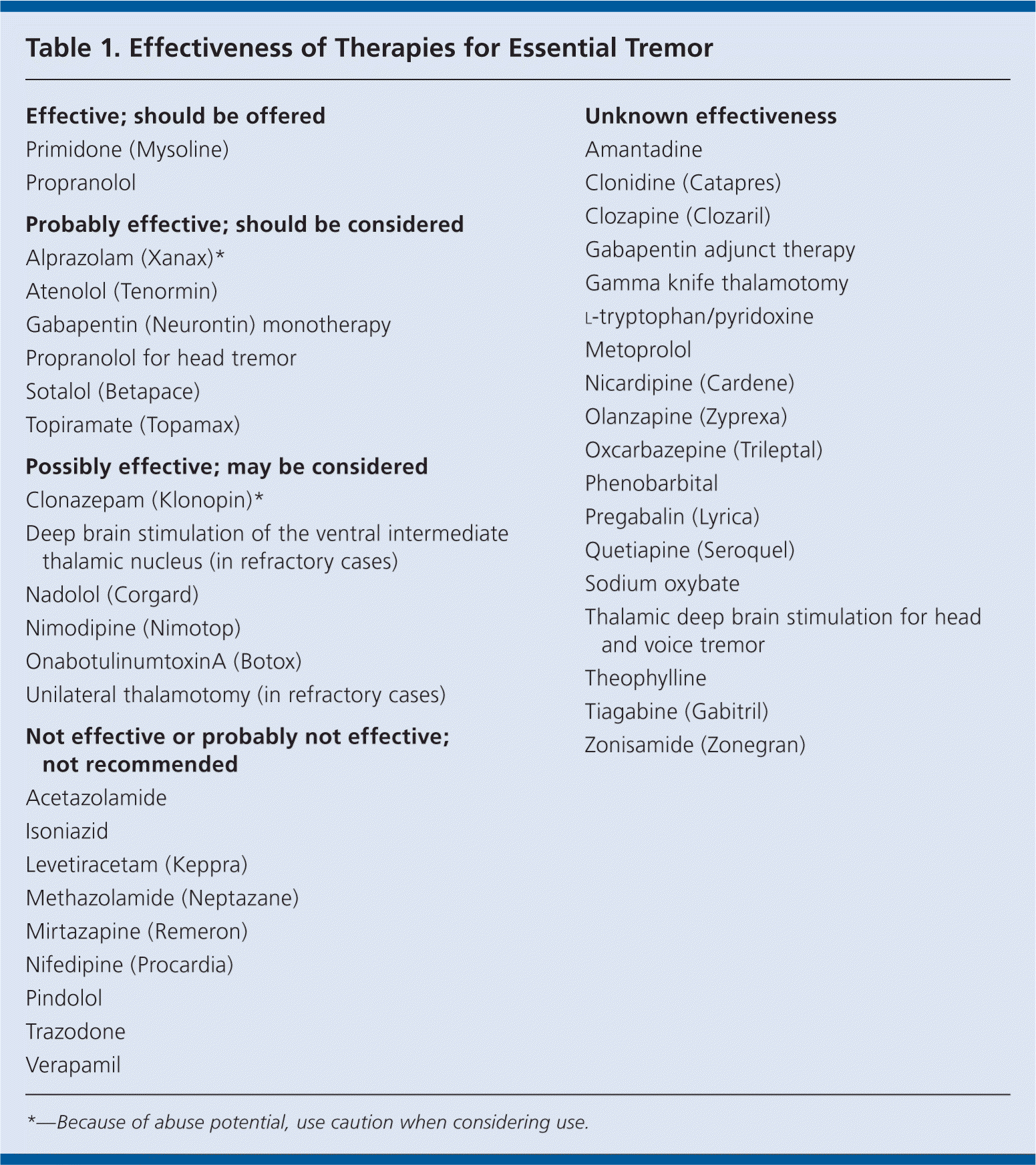
Am Fam Physician. 2012;86(3):292-293
Guideline source: American Academy of Neurology
Evidence rating system used? Yes
Literature search described? Yes
Guideline developed by participants without relevant financial ties to industry? No
Published source:Neurology, November 2011
Propranolol and primidone (Mysoline) are the most commonly used therapies for essential tremor, but these agents are ineffective for up to one-half of patients. In 2005, the American Academy of Neurology (AAN) published recommendations for the use of other therapies for essential tremor. Although no new data have been published for many of the drugs included in the 2005 guideline, results from studies on topiramate (Topamax), olanzapine (Zyprexa), levetiracetam (Keppra), pregabalin (Lyrica), zonisamide (Zonegran), and clozapine (Clozaril) are now available. Based on these results, the AAN has changed some of its recommendations for these agents (Table 1).

| Effective; should be offered |
| Primidone (Mysoline) |
| Propranolol |
| Probably effective; should be considered |
| Alprazolam (Xanax)* |
| Atenolol (Tenormin) |
| Gabapentin (Neurontin) monotherapy |
| Propranolol for head tremor |
| Sotalol (Betapace) |
| Topiramate (Topamax) |
| Possibly effective; may be considered |
| Clonazepam (Klonopin)* |
| Deep brain stimulation of the ventral intermediate thalamic nucleus (in refractory cases) |
| Nadolol (Corgard) |
| Nimodipine (Nimotop) |
| OnabotulinumtoxinA (Botox) |
| Unilateral thalamotomy (in refractory cases) |
| Not effective or probably not effective; not recommended |
| Acetazolamide |
| Isoniazid |
| Levetiracetam (Keppra) |
| Methazolamide (Neptazane) |
| Mirtazapine (Remeron) |
| Nifedipine (Procardia) |
| Pindolol |
| Trazodone |
| Verapamil |
| Unknown effectiveness |
| Amantadine |
| Clonidine (Catapres) |
| Clozapine (Clozaril) |
| Gabapentin adjunct therapy |
| Gamma knife thalamotomy |
| l-tryptophan/pyridoxine |
| Metoprolol |
| Nicardipine (Cardene) |
| Olanzapine (Zyprexa) |
| Oxcarbazepine (Trileptal) |
| Phenobarbital |
| Pregabalin (Lyrica) |
| Quetiapine (Seroquel) |
| Sodium oxybate |
| Thalamic deep brain stimulation for head and voice tremor |
| Theophylline |
| Tiagabine (Gabitril) |
| Zonisamide (Zonegran) |
Several new studies have addressed the effectiveness of topiramate in the treatment of essential tremor. The results of these studies confirmed those of previous studies, which showed that topiramate is an effective treatment. Therefore, no change was made to the 2005 recommendation that topiramate should be considered for patients with essential tremor.
The atypical antipsychotic olanzapine was compared with propranolol in one small crossover study. A total of 38 patients were randomized to receive 20 mg of olanzapine per day or 120 mg of propranolol per day. Both drugs significantly reduced scores on all evaluation measures after one month. However, a placebo effect could not be ruled out, and therefore, the AAN found insufficient evidence to support or refute the effectiveness of olanzapine in the treatment of essential tremor.
One randomized crossover study of levetiracetam evaluated the short-term effects of a single dose on limb tremor with only limited clinical benefits. Two randomized, crossover, lower-quality studies showed no benefit of levetiracetam in patients with essential tremor.
Pregabalin was evaluated in two studies. One was a randomized, parallel-group, double-blind, placebo-controlled trial involving 22 patients. Pregabalin was started at a dosage of 50 mg per day and titrated by 75 mg per day every four days to a maximum of 600 mg per day. A significant reduction in tremor amplitude was observed at a mean dosage of 286 mg per day. Improvements in action tremor limb scores on the Fahn-Tolosa-Marin Tremor Rating Scale were also noted. The second trial was a randomized crossover study involving 20 patients who received 150 to 600 mg of pregabalin per day, titrated over six weeks, or placebo. No improvements on the Tremor Rating Scale were noted in the treatment group, and quality of life scores were significantly lower. Based on the results of these two trials, the AAN determined that there is insufficient evidence to support or refute the effectiveness of pregabalin in the treatment of essential tremor.
The antiepileptic agent zonisamide was evaluated in several lower-quality studies. One of the studies was a double-blind, placebo-controlled, randomized trial involving 20 patients who received a mean dosage of 160 ± 50 mg of zonisamide per day. No significant improvements were observed on the Tremor Rating Scale, but tremor amplitude significantly improved in the treatment group compared with baseline. The other study found significant improvements on the Tremor Rating Scale in patients who received zonisamide. Based on the results of these studies, the AAN determined that there is insufficient evidence to support or refute the effectiveness of zonisamide in the treatment of essential tremor.
The antipsychotic clozapine was downgraded based on the results of a trial that evaluated the short-term effects of the drug in a controlled setting, followed by a open-label phase in patients who responded to treatment in the initial phase. The AAN found insufficient evidence to support or refute the effectiveness of clozapine for long-term use in patients with essential tremor.
